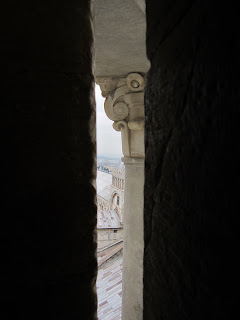By Geoffrey Dean
[Sequel to "Montepescali, Ardenza"]
Saturday, Jan. 5. After a night spent at La Coccinella Affittacamere, (The Ladybug House), a cozy and very reasonably priced guesthouse run by a young couple with wonderful enthusiasm and attention to detail, we made the short walk to the Piazza dei Miracoli. I felt inexplicably drawn to the piazza’s most famous “miracle,” the leaning tower of Pisa, and gladly parted with 18 Euros to be able to get the inside view. I took these (and many more!) photos to help tell the story of a structure whose beauty and magnetic power lies for me in its very “imperfection.”
The belltower of the Pisa cathedral started leaning to the southeast when construction reached the third level in 1178, due to a shallow foundation and unstable soil. Due to war, work on it continued only intermittently for another 200 years. The higher side of the top level was slightly shortened in an attempt to compensate for the lean. The total height of the tower on the higher side is 56.70 meters (about 186 ft).
After centuries of gradual movement and during a decade of renovations starting in 1990, the tower’s tilt was reduced from 5.5 to 4 degrees and its position stabilized. A major motivation for the renovation work was the May 1989 collapse of a freestanding medieval belltower in Pavia without any apparent warning. Metal supports in the Pisa tower’s inner cylinder help keep the tower steady, “guaranteeing” that it won’t collapse for at least 200 more years.
The steps are more scooped out on the “short” (southeast) side of the tower, where the shift in the center of gravity pushes the climber toward the outer wall. There are 296 well-worn steps to the top, or 294 if you use the short-side staircase on the 7th level.
 |
| A protected view |
A metal brace covers the seam joining a replacement column to its base. Most of the tower’s over 200 columns have been replaced.
 |
| A view of the back of the cathedral, Il Duomo di Pisa, built 11-12th century |
The cornices of the Corinthian columns are variations on several different designs. No two adjacent columns that I saw had the same design. I only noticed the type of metal column support seen here, apparently from an earlier period, on the level beneath the bell chamber.
 |
| A sliver of the cathedral as seen from this viewing point inside the staircase |
 |
| The cathedral and the baptistery (12-14th century, the largest in Italy) beyond it |
The bell chamber was added in 1372 and has seven bells.
 |
| Click to enlarge |
 |
| The spiral staircase leading to —and from—the bell chamber |
 |
| A closeup of the base |
 |
| Looking straight up |
 |
| The tower as seen from the southwest side of the cathedral, which is also said to lean slightly |
Next stop: Florence!
_______________
Copyright © 2013 by Geoffrey Dean
| Please comment |









No comments:
Post a Comment